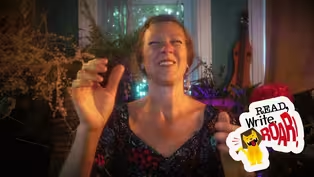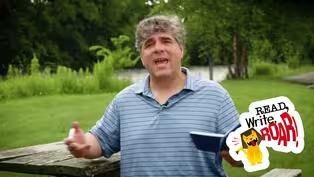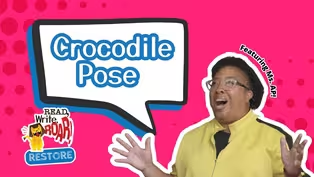Read, Write, ROAR!
Writing About Wildlife at a Nature Preserve | Paul Roose | Read, Write, ROAR!
Clip: Season 1 Episode 1015 | 4m 22sVideo has Closed Captions
Learn how preserves protect wildlife and provide homes for Michigan’s animals.
Visit a nature preserve and discover the amazing world of the Great Blue Heron. Learn how preserves protect wildlife and provide homes for Michigan’s animals.
Problems playing video? | Closed Captioning Feedback
Problems playing video? | Closed Captioning Feedback
Read, Write, ROAR! is a local public television program presented by Detroit PBS
Read, Write, ROAR!
Writing About Wildlife at a Nature Preserve | Paul Roose | Read, Write, ROAR!
Clip: Season 1 Episode 1015 | 4m 22sVideo has Closed Captions
Visit a nature preserve and discover the amazing world of the Great Blue Heron. Learn how preserves protect wildlife and provide homes for Michigan’s animals.
Problems playing video? | Closed Captioning Feedback
How to Watch Read, Write, ROAR!
Read, Write, ROAR! is available to stream on pbs.org and the free PBS App, available on iPhone, Apple TV, Android TV, Android smartphones, Amazon Fire TV, Amazon Fire Tablet, Roku, Samsung Smart TV, and Vizio.
Providing Support for PBS.org
Learn Moreabout PBS online sponsorship[Music] hi I'm naturalist Paul Roose today we are visiting the Thomas Township Nature Center and preserve we're going to explore the role of a nature preserve and why it's important for Michigan's plants and animals so grab a paper something to write with and your nature journal and let's go exploring Outdoors a nature preserve is an area that is protected and managed to preserve or maintain the land's plants animals and physical features the Thomas Township Nature Preserve is adjacent to the tid aasi river which provides a good source of water for wildlife first I'd like to introduce you to a bird the Nature Preserve is trying to protect take a look at this bird we can write down some of its features its size is about 4T tall its shape is Slender or thin and its color is blue gray it eats fish and frogs that are found in its habitat of rivers ponds and wetlands do you know what kind of bird this is a great blue heron follow me I want to show you a special place we have special permission to show you a place called a heron rookery we want to be quiet so we do not disturb the herand that are with eggs or baby birds in their nests anytime you are walking on a trail in a park or Nature Preserve I want to encourage you to stop and read the signs signs convey or communicate important information about the area and what you are seeing or even safety tips let's read this sign together up and to your left you will see a nesting area of the great blue heron they are a very solitary bird who prefers their privacy this is especially true now as it is mating season for these beautiful Birds step down to the left for photos however please try to turn around from here and do not disturb them we want them to stay here thank you the great blue herens have nests away from other birds in a grouping called a colony they do this to protect eggs from predators such as crows and raccoons two to six eggs are laid per nesting season you can look up in the trees and just make out darkened oval-shaped clumps in the trees can you count the clumps there are about 30 and each Clump is a big nest it's a nest that is four feet wide and four feet deep I bet some of you could even fit in it here's a closer look at a great blue heron on a nest let's pause and make some notes about what we've learned about the Heron and The Rookery you can even take some time to make a drawing of the nests in the trees find out more what you can do to protect the great blue heron and other wildlife of the Great Lakes by exploring a Nature Preserve in your area you and an adult in your life can also visit your public library to learn more about the Michigan activity pass this pass provides free or discounted access to more natural destinations throughout Michigan remember one way you can help protect nature and Wildlife is by reading and following directions on signs enjoy learning and exploring in the outdoors thank you for joining us if you want more fun ways to practice literacy skills don't forget to subscribe to the Michigan Learning Channel and be sure to check the description below for links to activity guides resources and more [Music]
Create a Garden Soundscape | Ms. Audra | Read, Write, ROAR!
Video has Closed Captions
Clip: S1 Ep1015 | 2m 25s | Hear bees buzzing, frogs croaking, and leaves rustling as you explore nature’s beauty. (2m 25s)
Feel of the Day: How to Capture Moments in Writing | Jeff Kass | Read, Write, ROAR!
Video has Closed Captions
Clip: S1 Ep1015 | 6m 14s | Learn how to turn everyday moments into vivid, captivating prose! (6m 14s)
Linear & Popular: Decoding Multisyllabic Words | Mrs. Mora | Read, Write, ROAR!
Video has Closed Captions
Clip: S1 Ep1015 | 4m 36s | Discover how to decode multisyllabic words like using prefixes, suffixes, and root words. (4m 36s)
Read, Write, ROAR! Restore - Crocodile Pose
Video has Closed Captions
Clip: S1 Ep1015 | 2m 28s | Learn the crocodile pose with Ms. AP in this 2-minute movement snack. (2m 28s)
Writing a Poem About Michigan’s State Tree | Mrs. Mask | Read, Write, ROAR!
Video has Closed Captions
Clip: S1 Ep1015 | 6m 33s | Explore Michigan’s state tree, the White Pine, through poetry! (6m 33s)
Providing Support for PBS.org
Learn Moreabout PBS online sponsorship

- Home and How To

Hit the road in a classic car for a tour through Great Britain with two antiques experts.












Support for PBS provided by:
Read, Write, ROAR! is a local public television program presented by Detroit PBS





